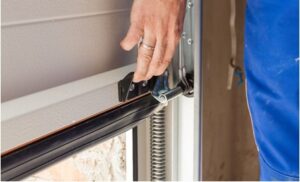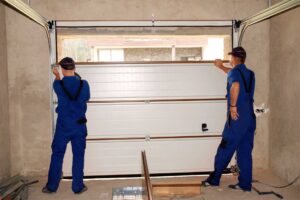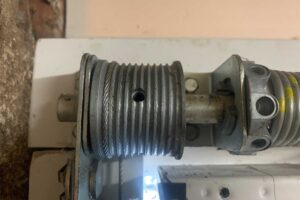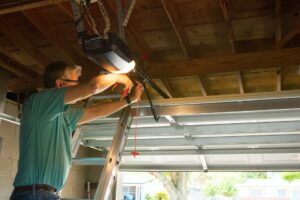
How to Tell If Your Garage Door Springs Need Replacing
Garage doors are often much heavier than they seem. With the exception of side-hinged garage
Whether you’re inside or out, there are few things more frustrating than a garage door that will not open or close. While you can be certain it’s down to a mechanical fault of some kind (or an electrical one if you have an automatic door opener), it can be difficult to determine the cause, particularly if you’re locked in or out of the garage.
In this article, we’re going to take a look at some of the reasons why your garage door won’t open or why your garage door won’t close. This should help you identify the problem and seek the assistance you need.
If you have an electronic garage door opener, it’s worth checking the remote before you start worrying about mechanical faults. Most remote door fobs have an LED that lights up when you press the button to open or close your garage door. If this isn’t lighting up, there’s a good chance the remote itself is at fault. Try changing the batteries to see if this helps. If not, you may need a replacement fob. If the fob is working but not activating the opener, the signal might be blocked. Try operating it from a different angle to see if this helps.
Despite their size and weight, garage doors are feats of precision engineering. There’s a lot going on behind the scenes that allows them to open and close so smoothly, and it doesn’t take much to jam the mechanism. A build-up of dirt and grime, a lack of lubrication, or bits of debris from your garage wall can easily get stuck in the runners, hinges, or roller axle (depending on the type of garage door you have). While it’s normally a simple matter to remove such obstructions, take care that you don’t trap your fingers while attempting to do so.

Up-and-over garage doors, roller shutter doors, and sectional garage doors all rely on a tension-wound cable to act as a counterweight to the door itself. It makes it easier to manually lift the door and holds the door in place when needed. These cables tend to be thin, metallic, and tightly-wound so they are under immense pressure. While these are very effective devices, they can cause problems if the cables become twisted or snapped.
If you can access the cable and see that it has been twisted, we urge you to call in a professional. Trying to untwist a garage door cable without the right experience or equipment can be extremely dangerous. These cables are razor-sharp and under constant strain. It doesn’t take much fiddling about to cause one to snap. Not only will that prevent your garage door from opening altogether, you run a double risk of injury. First, the cable snapping will whip back at tremendous speed, lacerating your skin, or worse. Secondly, with no counterweight to support it, your garage door will drop immediately, without warning, harming anyone or anything standing beneath it.
Limit settings (also known as sensitivity settings) tell your electric garage door opener how much force to exert when opening or closing the door. While garage doors come in all kinds of sizes and weights, depending on their construction, the motors used to open them automatically tend to be one-size-fits-all. They can’t tell themselves how heavy your garage door is, so the electronic opener needs to be programmed to do so by adjusting its limit settings.
If you get these settings wrong, your opening device will think your garage door is much heavier (or lighter) than it actually is. This results in it opening and closing the door with too much or too little force. While too little force can be frustrating, as the motor won’t generate enough power to open or close the door, too much force is far worse. On this setting, it will pull the door open at great speed, possibly damaging it, and close it at the same velocity, perhaps injuring anybody standing in the way who might have avoided a more slowly descending door.
We’ve already discussed what happens when your remote fob isn’t working and can’t operate your electric door opener. However, sometimes the fault lies not with the remote, but with the motor that operates the door. There can be any number of reasons why your motor packs in—everything from dust in the fan to a shorted circuit board. Unless you have experience with such devices, you may need to call in the experts.
Help is at hand if your garage door won’t open or your garage door won’t close. Call Local Garage Door Repair Man today on 0203 816 0797 or 07983 433921 for reliable garage door repairs in London and across the South East. Alternatively, send an email to info@localgaragerepairman.co.uk to arrange a call-out, or to receive a free, no-obligation quote.

Garage doors are often much heavier than they seem. With the exception of side-hinged garage

There’s no reason why your garage doors shouldn’t last you for decades, so long as

It is easy to take our garage doors for granted – until something goes wrong.

As a nation – we are devoted to DIY, with many a bank holiday weekend
At Local Garage Door Repair Man, we provide manual and electric garage door repairs (including garage door cable repairs) as well as installing garage door openers. For essential repairs to garage doors across Ashford, Camberley, Crowthorne, Farnborough, Feltham, Fleet, Hillingdon, Hounslow, Shepperton, Slough, Sunbury-on-Thames, Uxbridge, Windlesham, and beyond, give us a call today.
